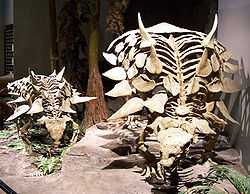Polacanthidae
| Polacanthids Temporal range: Late Jurassic - Late Cretaceous, 155–93.9Ma | |
|---|---|
 | |
| Fossil skeleton of Gargoyleosaurus parkpinorum, Denver Museum of Nature and Science | |
| Scientific classification | |
| Kingdom: | Animalia |
| Phylum: | Chordata |
| Clade: | Dinosauria |
| Order: | †Ornithischia |
| Clade: | †Eurypoda |
| Suborder: | †Ankylosauria |
| Family: | †Polacanthidae Wieland, 1911 |
| Genera[1] | |
|
Gargoyleosaurus | |
| Synonyms | |
Polacanthidae is a grouping of ankylosaurs, possibly primitive nodosaurids. Polacanthids are Late Jurassic to Late Cretaceous in age. From North America, polacanthids are observed to be 155 to 126 million years old, from Europe they are 140 to 126 mya, and, until recently, no polacanthids have been known from any other continents. Before polacanthids from other continents were known, Kirkland observed they appeared to become extinct about the same time a land bridge opened between Asia and North America.[2] Now though, Taohelong, Dongyangopelta and Zhejiangosaurus are known from Asia and are dated at 113 to 93.9 mya.
Polacanthids were somewhat more lightly armoured than more advanced ankylosaurids and nodosaurids. Their spikes were made up of thin, compact bone with less reinforcing collagen than in the heavily armoured nodosaurids. The relative fragility of polacanthine armour suggests that it may have been as much for display as defense.[3]
Classification

The family Polacanthidae was named by Wieland in 1911 to refer to a group of ankylosaurs which seemed to him intermediate between the ankylosaurids and nodosaurids. This grouping was ignored by most researchers until the late 1990s, when it was used as a subfamily (Polacanthinae) by Kirkland for a natural group recovered by his 1998 analysis suggesting that Polacanthus, Gastonia, and Mymoorapelta were closely related within the family Ankylosauridae. Kenneth Carpenter resurrected the name Polacanthidae for a similar group which he also found to be closer to ankylosaurids than to nodosaurids. Carpenter became the first to define Polacanthidae as all dinosaurs closer to Gastonia than to either Edmontonia or Euoplocephalus.[4] Most subsequent researchers placed polacanthines as primitive ankylosaurids, though mostly without any rigorous study to demonstrate this idea. The first comprehensive study of 'polacanthid' relationships, published in 2012, found that they are ither an unnatural grouping of primitive nodosaurids, or a valid subfamily at the base of Nodosauridae.[5] Recently, Polacanthinae was deemed the improper rank for the group by Kirkland et al. (2013).[1]
Biogeography

The near simultaneous appearance of nodosaurids in both North America and Europe is worthy of consideration. Europelta is the oldest nodosaurid from Europe, it is derived from the lower Albian Escucha Formation. The oldest western North American nodosaurid is Sauropelta, from the lower Albian Little Sheep Mudstone Member of the Cloverly Formation, at an age of 108.5±0.2 million years. Eastern North American fossils seem older. Teeth of Priconodon crassus from the Arundel Clay of the Potomac Group of Maryland, which dates near the Aptian–Albian boundary. The Propanoplosaurus hatchling from the base of the underlying Patuxent Formation, date to the upper Aptian, making Propanoplosaurus the oldest nodosaurid.[1]
Polacanthids are known from pre-Aptian fauna from both Europe and North America. The timing of the appearance of nodosaurids on both continents indicates the origins of the clade preceded the isolation of North America and Europe, pushes the groups date of evolution back to at least the "middle" Aptian. The separation of Nodosauridae into European Struthiosaurinae and North American Nodosaurinae by the end of the Aptian provides a revised date for the isolation of the continents from each other with rising sealevel.[1]
 |
| Timeline of age of polacanthid and nodosaurid genera. Genera are colour-coded based on continent: North American genera are green; European genera are blue; Asian genera are claret; genera from other continents are black. The dashed line separates the Polacanthids (above) from the Nodosaurids (below). Classification is based on Kirkland et al.[1] |
References
- ↑ 1.0 1.1 1.2 1.3 1.4 Kirkland, J. I.; Alcalá, L.; Loewen, M. A.; Espílez, E.; Mampel, L.; Wiersma, J. P. (2013). Butler, Richard J, ed. "The Basal Nodosaurid Ankylosaur Europelta carbonensis n. gen., n. sp. From the Lower Cretaceous (Lower Albian) Escucha Formation of Northeastern Spain". PLoS ONE 8 (12): e80405. doi:10.1371/journal.pone.0080405.
- ↑ Kirkland, J. I. (1996). "Biogeography of western North America's mid-Cretaceous faunas - losing European ties and the first great Asian-North American interchange". Journal of Vertebrate Paleontology 16 (45A): Supplement to 3.
- ↑ Hayashi, S., Carpenter, K., Scheyer, T.M., Watabe, M. and Suzuki. D. (2010). "Function and evolution of ankylosaur dermal armor". Acta Palaeontologica Polonica 55 (2): 213–228. doi:10.4202/app.2009.0103.
- ↑ Carpenter K (2001). "Phylogenetic analysis of the Ankylosauria". In Carpenter, Kenneth(ed). The Armored Dinosaurs. Indiana University Press. pp. 455–484. ISBN 0-253-33964-2.
- ↑ Thompson, R.S., Parish, J.C., Maidment, S.C.R. and Barrett, P.M. (2012). "Phylogeny of the ankylosaurian dinosaurs (Ornithischia: Thyreophora)." Journal of Systematic Palaeontology, 10(2): 301-312. doi:10.1080/14772019.2011.569091